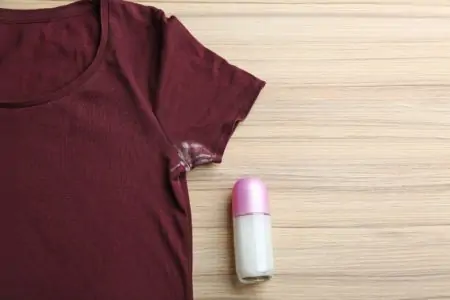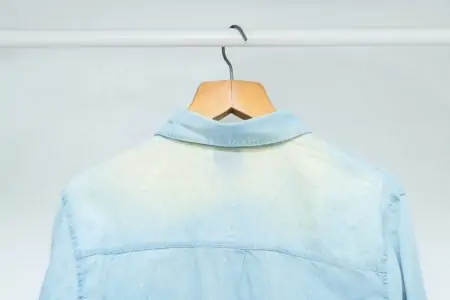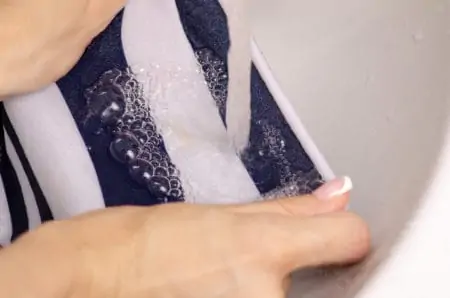Deodorant stains can be so unsightly that it makes wearing a favorite t-shirt embarrassing sometimes. I can’t tell you the number of times I’ve tossed an old shirt out because of deodorant stains — they’re practically impossible to remove!
But we’ve hacked the process; they aren’t an issue for our clothing anymore. These are our tried and true methods for how to remove deodorant stains from clothing.
Key Takeaways
- Soak the garment in white vinegar for one hour.
- Brush the stained area with an old toothbrush.
- Wash the item as you normally would using the warmest water possible for the garment type.
- Dry if the stain has been removed.
How to Remove Deodorant Stains from Whites
Keeping whites white is a difficult practice for many people. When we buy white clothing, it’s an utmost priority to keep that garment white. With the right techniques, you can. But you have to know how to remove deodorant stains, as this is a very common culprit for ruining your whites.
Distilled White Vinegar
This is our absolute favorite method for removing deodorant stains from white clothing. But the good thing is — it also works for colored clothing!
- Soak the garment in white vinegar for one hour.
- Brush the stained area with an old toothbrush.
- Wash the item as you normally would using the warmest water possible for the garment type.
- Dry if the stain has been removed.
Top Tip
Aspirin Tablets
Did you know that aspirin comes in handy for removing a variety of stains? This is suitable for white clothing only, so don’t use it on dark or colorful clothing.
- Crush up five aspirin tablets.
- Mix the powder with a tiny amount of water to create a paste.
- Apply this paste to the stained area.
- Wash the garment as normal.
- Only dry if the stains are gone.
Lemon Juice
Lemon juice is a natural way to remove stains and brighten clothes. You should only use this for white or light-colored clothes as it can have a bleaching effect.
- Cut a lemon in half. Squeeze the juice onto the stained area.
- Add a pinch of table salt.
- Rub the mixture into the shirt using your finger. Continue until the stain disappears.
- Leave the garment in the sun for one hour to brighten it up.
- Rinse the area.
- Wash as normal.
- Dry well.
Baking Soda and Hydrogen Peroxide
This is an awesome method for getting rid of yellow deodorant and antiperspirant stains on white clothing.
- Mix ⅓ cup of water, ⅓ of hydrogen peroxide, and ⅓ cup of baking soda.
- Use a spoon to apply the solution directly onto the stain.
- Use a generous amount to saturate the stain.
- Leave the solution on the garment overnight.
- In the morning, use a spoon to scrape off the excess solution.
- Wash the garment as normal.
- Dry if the stain is gone.
How to Remove Deodorant Stains from Dark Colors
What about removing stains from dark colors without dulling or bleaching the fabric? We’ve got you covered.
All you need for this method is a cloth and water. Yep, that’s right.
Simply dampen a cloth and rub the fabric until the stain has been removed. Wash as normal with a heavy-duty laundry detergent for dark clothes. Dry if the stains are gone.
Caution
How to Remove Deodorant Stains from Bras
Using a damp cloth is sometimes enough to remove deodorant stains from bras. Work in a circular motion and have patience as it can take a few minutes. If that doesn’t work, though, we have a few other suggestions.
Dryer Sheet
Make sure to use a used dryer sheet for this, as this will minimize leaving behind any residue.
- Bunch up the dryer sheet into a little ball.
- Rub the stain in a circular motion firmly. The stain should slowly start to disappear.
- Wash as normal.
Before You Start
Makeup Remover Wipe
Makeup remover wipes can do a great job at removing deodorant stains on bras. Simply wipe it over the stain in circular motions until the stain lifts. Wash as normal.
You can also use liquid makeup remover, but first, apply it to a cotton pad before removing the deodorant stain.
How to Prevent Deodorant Stains on Clothes
While you can take time to remove existing deodorant stains, it will save you time if you know how to prevent them in the first place. Here are our top tips:
- Choose your deodorant wisely: If a deodorant has a lot of alcohol, fragrance, or aluminum, it’s more likely to leave stains (1). What about switching to a natural deodorant, one with a neutral pH level or an acidic antiperspirant?
- Let your deodorant dry completely before putting on your clothes: It’s a good idea to put your deodorant on while you’re still on a towel or bathrobe after your shower. Do your hair, makeup, or skincare routine before getting dressed.
- Wash your t-shirts, shirts, and vests after every wear: If you don’t let the deodorant mark set, it won’t stain. It should be easy enough to clean with just your normal laundry routine.
- Avoid creamy deodorants: Creamy white deodorants easily leave behind white stains, especially on darker clothing.
- Don’t put on too much deodorant: Sometimes less is more. Too much can easily lead to stains.
- Use a hairdryer to speed up the drying process: This works if you find your underarms are still slightly damp and you’re already running late for work!
FAQs
Removal and Prevention Is Key
Most people wear deodorant, so witnessing the horror of these stains is a common occurrence for many of us! But with the right prevention methods, switching up what deodorant you use, and knowing how to remove the stains if they do appear is key.
This will help preserve your garments for longer. You’ll never be embarrassed about wearing an old t-shirt again since it’s now totally stain-free.










